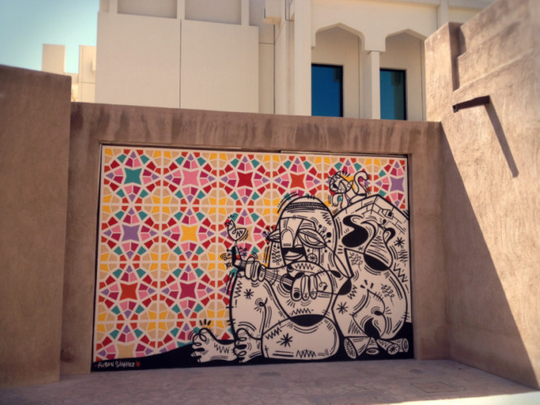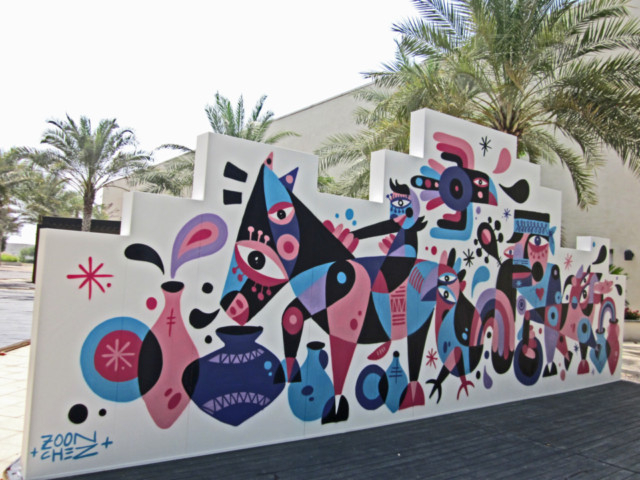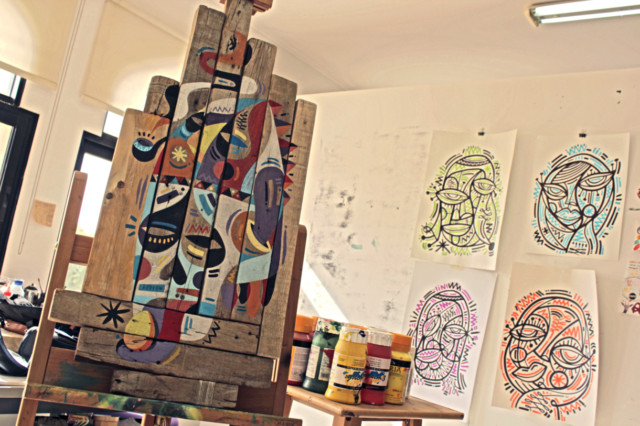
Graffiti is illegal in most places around the world, including the UAE. So the giant graffiti that has recently appeared in Jumeirah is quite an unusual sight. The colourful painting, covering the entire wall of a shop on Jumeirah Beach Road, features a part-human-part-animal figure riding a bicycle. And it is even signed by the artist, Ruben Sanchez.
The Spanish street artist has also created other such murals in the Al Fahidi Historical Neighbourhood and at Manarat Al Saadiyat in Abu Dhabi’s Saadiyat Cultural District.
Sanchez is in Dubai for a one-year residency at Tashkeel. And he has created quite a buzz about street art here with his eye-catching murals and through his fun graffiti and skateboard customisation workshops for children and adults.
“In Europe graffiti artists must pay hefty fines if they get caught, but in the UAE they can go to jail. So when Tashkeel offered me this residency, I expected to be working only in the studio. But I have been fortunate to get permission to do these public projects. I hope this will open the door for other street artists to showcase their work here; and maybe even to organise a street art festival that would bring the best graffiti artists from around the world to this city,” he says.
Sanchez grew up in Madrid and began using the city’s walls as his canvas when he was just 13. “The fact that graffiti is illegal was a big attraction at that age, and it was exciting to work quickly, surreptitiously and anonymously. Initially it was about establishing my identity by getting the maximum exposure for my tag and competing with other artists to have the most tags around the city or the highest or biggest graffiti. But later I began to like street art because it is a way to express yourself and let people know your opinions about various issues,” he says.
Although he has been painting on skateboards and walls since childhood, Sanchez has no formal training in art. He taught himself design and illustration from the internet, and has been working as a designer and illustrator since he moved to Barcelona in 2001. But he continues to do graffiti in his spare time, and has worked hard to develop his distinct style. “A graffiti artist cannot sign his work, so it is important to develop a unique style that people, especially those in the graffiti circle can instantly recognise. Finding your signature style is a long process, but now when people see a mural featuring an animal, in Paris, Denmark or Dubai, they know I have been to the city,” he says.
His style is inspired by cubism, Spanish culture and the bright colours of Spain, but Sanchez always tries to incorporate elements from the local culture in his work. For instance, his mural in Bastakiya features a man playing the Oud with traditional Islamic patterns in the background. “I have fallen in love with these geometric patterns and wanted to play with my typical colours in these patterns. This area is one of the oldest neighbourhoods in Dubai, and through this image of a man relaxing by the fire, I have tried to depict what life must have been like a hundred years ago for the Iranian immigrants who lived here. This is the first time I have combined a colourful background with a black and white image and I am pleased with the effect. The work was commissioned by Tashkeel during the Sikka art fair, giving me a great opportunity to demonstrate how street art can add character to a place,” he says.
Influences of Emirati culture and environment can also be seen in the acrylic on canvas and wood paintings Sanchez is working on in his studio at Tashkeel. These include a diptych featuring a desert fox and an owl as symbols of day and night in the desert; and paintings of Bedouins and animal figures done on panels cobbled together from pieces of wood that he found in the desert. “These weather-beaten pieces of wood remind me of the dilapidated walls, doors and windows of abandoned houses on which I like to paint outdoors. I enjoy the freedom of putting them together in different shapes, and I like the idea that this wood had another life before it became part of my work,” he says.
This is the artist’s first residency and he is enjoying every moment. “I was lucky that somebody from Tashkeel saw my graffiti in Spain and liked it. In Barcelona, my job took up most of my time, but now I can focus totally on my art. The support from Tashkeel is excellent in terms of materials, studio facilities and opportunities to teach and create street art. I want to use this time to do studio work, which is important for developing my artistic career, because you cannot earn a living from street art. But I do not ever want to give up street art, because that is what gives me the adrenaline rush and the chance to create really huge artworks,” Sanchez says.




